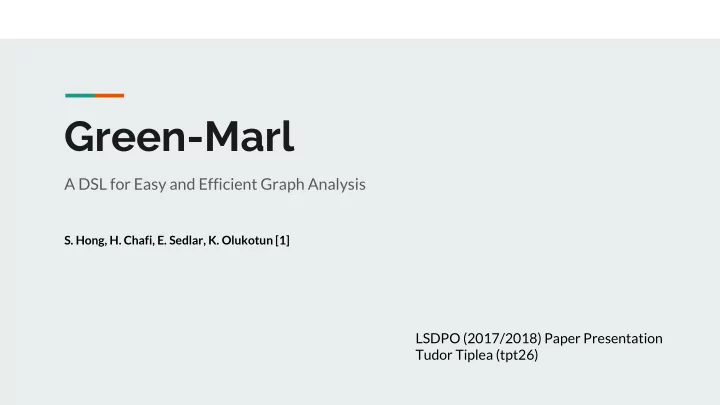

Green-Marl A DSL for Easy and Efficient Graph Analysis S. Hong, H. Chafi, E. Sedlar, K. Olukotun [1] LSDPO (2017/2018) Paper Presentation Tudor Tiplea (tpt26)
Problem Paper identifies three major challenges in large-scale graph analysis: ● 1) Capacity — graph won’t fit in memory 2) Performance — many graph algorithms fail to perform on large graphs 3) Implementation — hard to write correct and efficient graph algorithms Tackle last two by only focusing on graphs that fit in memory ● In this case, a major impediment to performance is memory latency (working-set size ● exceeds cache size)
Towards a solution Can improve performance by exploiting data parallelism abundant in graphs ● However, performance and implementation are not orthogonal ● Parallelism makes implementation more difficult ● Need to think about race conditions, deadlock, etc. ● There needs to be a balance ●
Contribution Green-Marl — A Domain-Specific Language ● Exposes inherent parallelism ○ Has constructs designed specifically for easing graph algorithm implementation ○ Expressive but concise ○ A Green-Marl compiler ● Automatically optimises and parallelises the program ○ Produces C++ code (for now) ○ Extendable to target other architectures ○ An evaluation of a number of graph algorithms implemented in Green-Marl claiming an ● increase in performance and productivity
The language
Overview Operates over graphs (directed or undirected) and associated properties (one kind of data ● stored in each node/edge) Assumes graphs are immutable and no aliases between graph instances or properties ● Given a graph and a set of properties it can compute ● A scalar value (e.g. conductance of graph) ○ A new property ○ A subgraph selection ○ Has typed data : primitives, nodes/edges bound to a graph, collections ●
Parallelism Group assignments (implicit) ● e.g. graph_instance.property = 0 ○ Parallel regions (explicit) ● Uses fork-join parallelism ○ The compiler can detect some possible conflicts in here ○ Reductions ● Have syntactic sugar constructs ○ Can specify at which iteration scope reduction happens ○
Traversals Can traverse graphs in either BFS or DFS order ● Each allows both a forwards and a backwards pass ● Can prune the search tree using a boolean navigator ● For DFS the execution is sequential ● BFS has level-synchronous execution ● Nodes at same level can be processed in parallel ○ But parallel contexts are synchronised before next level ○ During a BFS traversal each node exposes a collection of its upwards and downwards ● neighbours
The compiler
Structure Parsing & checking: ● Can detect some data conflicts (Read-Write, Read-Reduce, Write-Reduce, Reduce-Reduce) ○ Architecture independent optimisations: ● Loop fusion, code hoisting, flipping edges (uses domain knowledge) ○ Architecture dependent optimisations: ● NOTE: currently the compiler only parallelises the inner-most graph-wide iteration ○ Code generation: ● Assumes gcc as compiler, uses OpenMP as threading library ○ Uses efficient code-generation templates for DFS and BFS ○
Evaluation
Methodology Use synthetically generated graphs (generally 32 million nodes, 256 million edges): ● uniform degree distribution ○ power-law degree distribution ○ Test on a number of graph algorithms: ● Betweenness centrality ○ Conductance ○ Vertex Cover ○ PageRank ○ Kosaraju (strongly connected components) ○ Compare with implementations using the SNAP library ●
Productivity gains
Performance gains (BC)
Performance gains (Conductance)
Opinion
What’s neat Language is easy to use ● Using a compiler means: ● Users don’t have to worry about applying optimisations themselves ○ Programs can target multiple architectures ○ Producing high-level code (like C++) means the graph analysis code can be integrated in ● existing applications with minimal changes Further work could even support out-of-memory graphs ● E.g. compile Green-Marl to Pregel ○ Or using GPUs ●
But... The ecosystem is very limited (for now, at least): ● Cannot modify the graph structure ○ Can only compile to C++ ○ Only inner-most graph-wide loops are parallelised ○ Keep in mind none of the optimisations are novel ● Also, measuring productivity gains in lines of code seems very subjective and the claims ● should be taken with a pinch of salt
References [1] S. Hong, H. Chafi, E. Sedlar, K.Olukotun: Green-Marl: A DSL for Easy and Efficient Graph Analysis , ASPLOS, 2012. All code snippets and evaluation plots in this presentation are extracted from the paper above.
Questions Thank you!
Recommend
More recommend